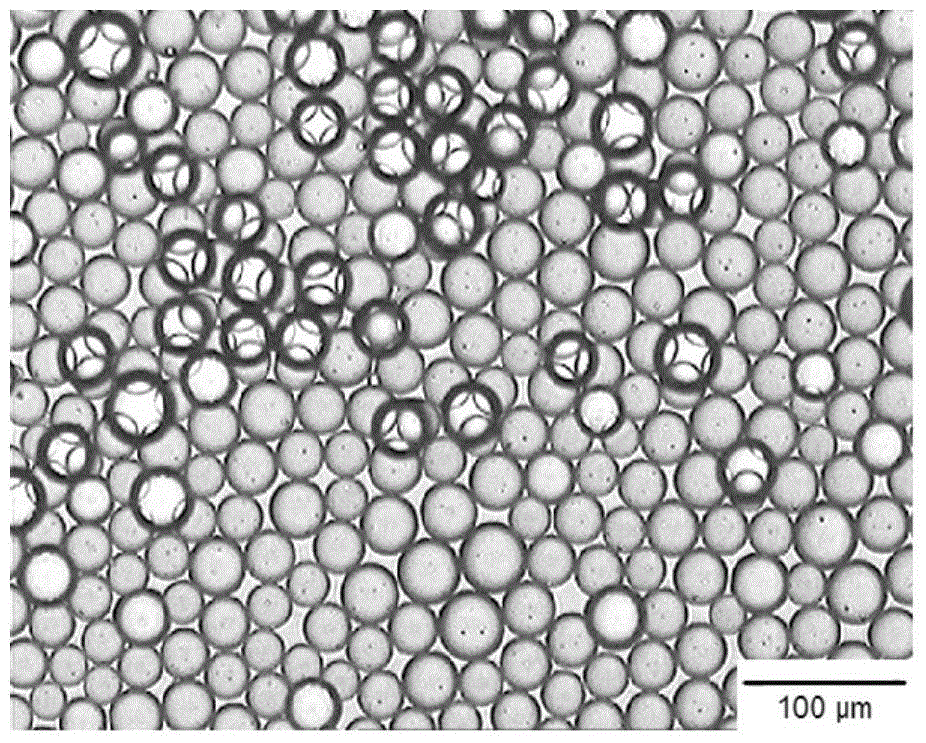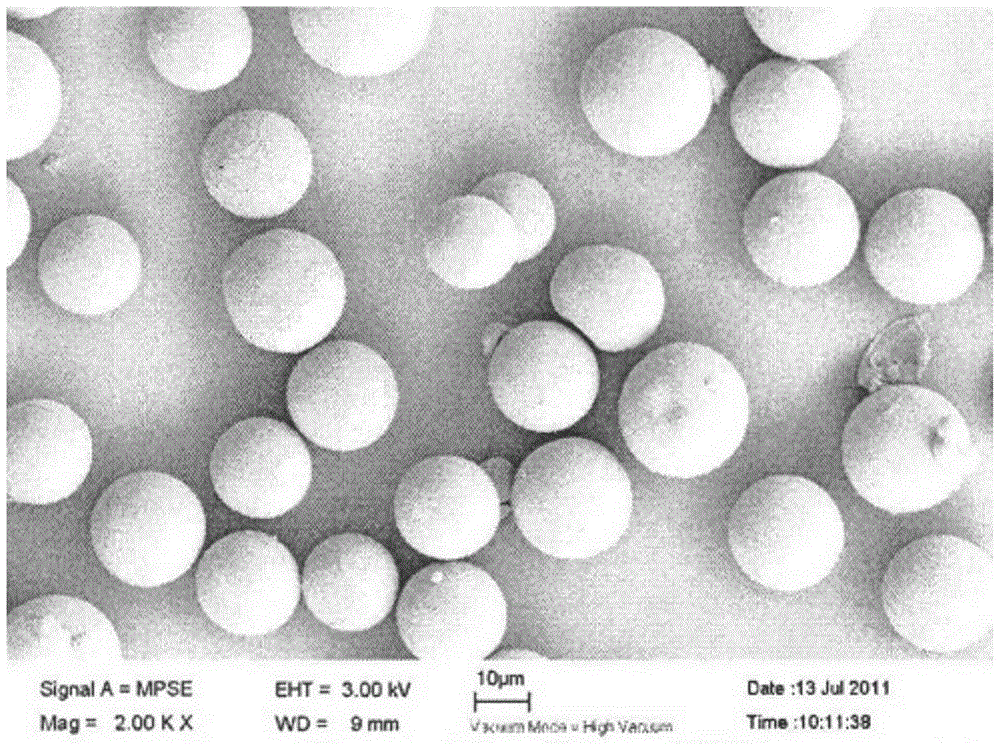Monodisperse copolymer microsphere and preparation method thereof
A monodisperse and copolymerization technology, applied in the field of polymer chemistry, can solve the problems of adsorption sample range and adsorption effect limitation, and achieve the effect of narrow particle size distribution of microspheres, good emulsion monodispersity, and high sample capacity.
- Summary
- Abstract
- Description
- Claims
- Application Information
AI Technical Summary
Problems solved by technology
Method used
Image
Examples
Embodiment 1
[0056] Mix 1.0 g of sodium lauryl sulfate, 0.5 g of polyvinylpyrrolidone, and 1000 mL of deionized water, and stir at 30° C. for 3 hours to form an aqueous phase. Mix 50g of N-vinylpyrrolidone, 70g of divinylbenzene, 1.0g of azobisisobutyronitrile, 60g of toluene, and 60g of liquid paraffin to form an oil phase. Select a 5μm SPG membrane to prepare a monodisperse emulsion. Under a nitrogen pressure of 0.06MPa, press the oil phase through the membrane into the water phase to form an emulsion. For the emulsion, see figure 1 .
[0057] The emulsion was transferred into a four-neck flask, nitrogen gas was passed for 30 minutes, the stirring speed was 150 rpm, and the reaction was carried out at 80° C. for 15 hours.
[0058] Finally, the steps of filtering, washing, re-filtering, drying, and porogen extraction are carried out according to conventional methods, and the copolymerized microspheres are recovered. The obtained copolymerized microspheres have good monodispersity, a par...
Embodiment 2
[0060] 1.0 g of dioctyl sodium succinate sulfonate, 0.5 g of polyvinylpyrrolidone and 1000 mL of deionized water were mixed, and stirred at 30° C. for 3 hours to form an aqueous phase. Mix 40g of N-vinylpyrrolidone, 10g of methyl methacrylate, 70g of divinylbenzene, 1.0g of azobisisobutyronitrile, and 60g of toluene to form an oil phase. A 1.8 μm SPG membrane was selected to prepare a monodisperse emulsion. Under a nitrogen pressure of 0.08 MPa, the oil phase was pressed through the membrane into the water phase to form an emulsion.
[0061] The emulsion was transferred into a four-necked flask, nitrogen gas was passed for 30 minutes, the stirring speed was 180 rpm, and the reaction was carried out at 80° C. for 15 hours.
[0062] Finally, the steps of filtering, washing, re-filtering, drying, and porogen extraction are carried out according to conventional methods, and the copolymerized microspheres are recovered. The obtained copolymerized microspheres have good monodispers...
Embodiment 3
[0064] Mix 1.0 g of sodium lauryl sulfate, 0.6 g of polyvinylpyrrolidone, and 1000 mL of deionized water, and stir at 30° C. for 3 hours to form an aqueous phase. Mix 60g of N-vinylpyrrolidone, 50g of divinylbenzene, 1.0g of azobisisobutyronitrile, and 100g of toluene to form an oil phase. A 10 μm SPG membrane was selected to prepare a monodisperse emulsion, and under a nitrogen pressure of 0.05 MPa, the oil phase was pressed through the membrane into the water phase to form an emulsion.
[0065] The emulsion was transferred into a four-necked flask, nitrogen gas was passed for 30 minutes, the stirring speed was 180 rpm, and the reaction was carried out at 80° C. for 15 hours.
[0066] Finally, the steps of filtering, washing, re-filtering, drying, and porogen extraction are carried out according to conventional methods, and the copolymerized microspheres are recovered. The obtained copolymerized microspheres have good monodispersity, a particle size of 78 μm, and a specific ...
PUM
| Property | Measurement | Unit |
|---|---|---|
| Particle size | aaaaa | aaaaa |
| Specific surface area | aaaaa | aaaaa |
| Particle size | aaaaa | aaaaa |
Abstract
Description
Claims
Application Information
 Login to View More
Login to View More - R&D
- Intellectual Property
- Life Sciences
- Materials
- Tech Scout
- Unparalleled Data Quality
- Higher Quality Content
- 60% Fewer Hallucinations
Browse by: Latest US Patents, China's latest patents, Technical Efficacy Thesaurus, Application Domain, Technology Topic, Popular Technical Reports.
© 2025 PatSnap. All rights reserved.Legal|Privacy policy|Modern Slavery Act Transparency Statement|Sitemap|About US| Contact US: help@patsnap.com



